4 December. Small-scale breeding expected along Red Sea coasts
The Desert Locust situation continues to remain calm in all countries and no significant developments are expected during December.
In the Western Region, isolated solitarious adults are present in parts of northwest Mauritania, northern Niger, Algeria and northeast Chad, and small-scale breeding is underway in a few places but locust numbers remain low and insignificant. During the forecast period, small-scale breeding could occur if rains fall in northwest Mauritania and Western Sahara. Locust numbers will decline in the northern Sahel while a few scattered adults are likely to persist in parts of northern Mali and Niger.
In the Central Region, low numbers of solitarious adults are present in a few places of the winter breeding areas along the Red Sea coast in Yemen and Sudan. Small-scale breeding will occur during December along both sides of the Red Sea, especially on the coastal plains in Saudi Arabia where heavy rains fell last month.
In the Eastern Region, no locusts are present and no significant developments are expected in the coming month.
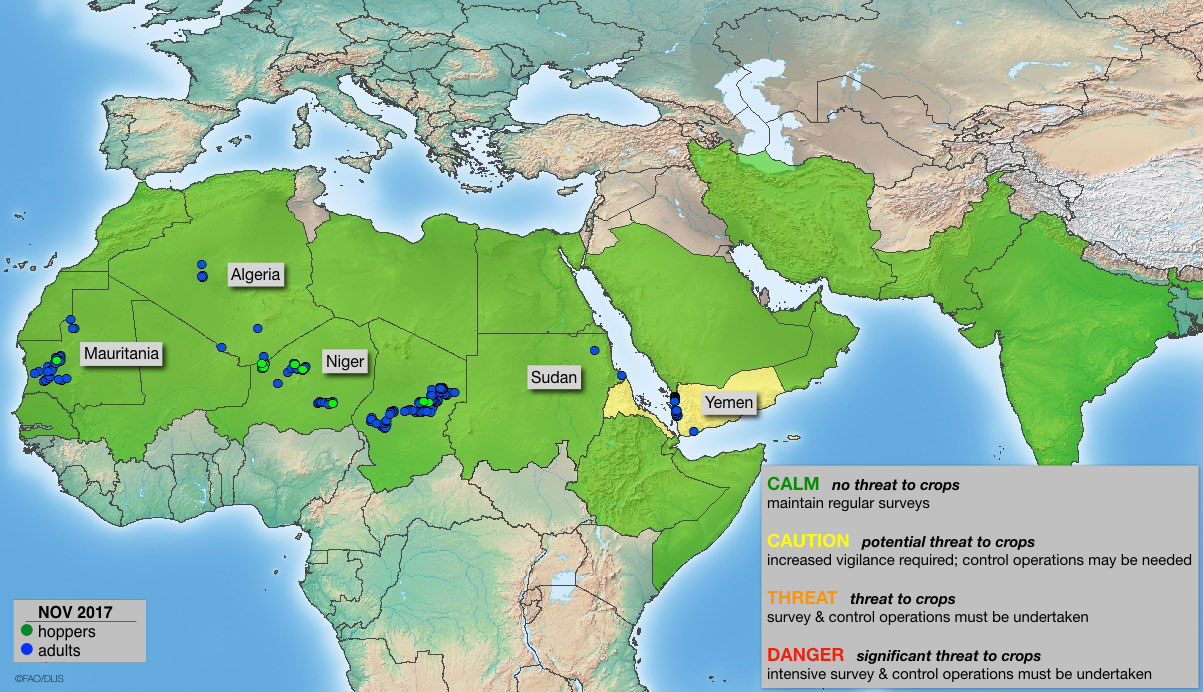
Current situation & threat.
3 November. Small-scale breeding in progress but situation remains calm
The Desert Locust situation continues to remain calm.
Seasonal rains have ended in the summer breeding areas of the Sahel in West Africa and Sudan as well as along the Indo-Pakistan border. Consequently, vegetation is nearly dry and locust numbers have declined with only a few small infestations remaining in northern Niger, the extreme south of Algeria, southern Mauritania and in Cholistan, Pakistan.
Most of the summer-bred locust adults moved from southern Mauritania to the western part of the country where small-scale breeding is in progress but locust numbers remain low. This breeding is expected to continue during November and could extend into northwest Mauritania and adjacent areas of the southern Western Sahara.
In the winter breeding areas along the coastal plains of the Red Sea, small-scale breeding is expected to commence in Sudan and Saudi Arabia during November, causing locust numbers to increase slightly. Breeding is probably already in progress on the coast of Yemen but this has not been confirmed because field surveys cannot be conducted due to insecurity. In Eritrea, a second generation of breeding is thought to be underway in one area on the Red Sea coast near Massawa where good rains have fallen since May. This will continue during November, causing locust numbers to increase with the possibility of small groups forming. Strict vigilance is required.
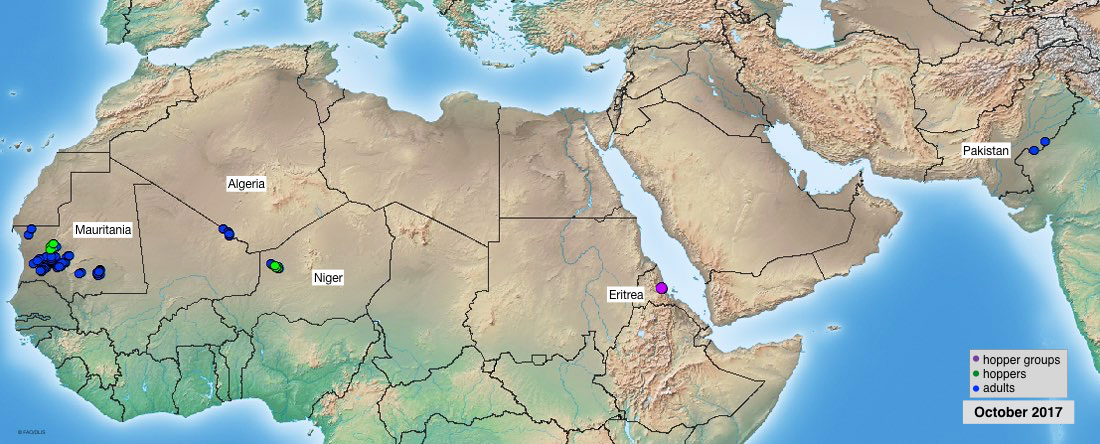
Current situation.
2 October. Situation remains calm, locusts shift to winter breeding areas
The current Desert Locust situation continues to remain calm in all countries.
Despite good rainfall and favourable breeding conditions in the past few months, very few locusts have been detected during recent surveys in the summer breeding areas of the northern Sahel in West Africa and Sudan, and along both sides of the Indo-Pakistan border.
In Mauritania, low numbers of adults shifted from the south to the west of the country where small-scale breeding will increase during October that could extend to areas in Western Sahara where good rains fell after mid-September.
Low numbers of adults will move from the interior of Sudan to the winter breeding areas on the Red Sea coast in Sudan where small-scale breeding will occur there as well as on the coasts of Yemen, Saudi Arabia, Eritrea and perhaps southeast Egypt from October onwards.

Current situation.
1 September. Situation calm as good rains continue in summer breeding areas
The current Desert Locust situation remains calm in Africa, the Near East and southwest Asia.
Despite good rainfall and favourable breeding conditions, only low numbers of solitarious locusts are currently present in the summer breeding areas of the northern Sahel in West Africa and Sudan, in the interior of Yemen and along both sides of the Indo-Pakistan border.
Nevertheless, locust numbers are expected to increase slightly during September as breeding continues from Mauritania to Sudan, in the interior of Yemen and, to a lesser extent, in western India and adjacent border areas of Pakistan. Once vegetation starts to dry out at the end of the summer, locusts may concentrate and perhaps form a few very small groups in some places.
Regular surveys should be conducted in all areas wherever possible.
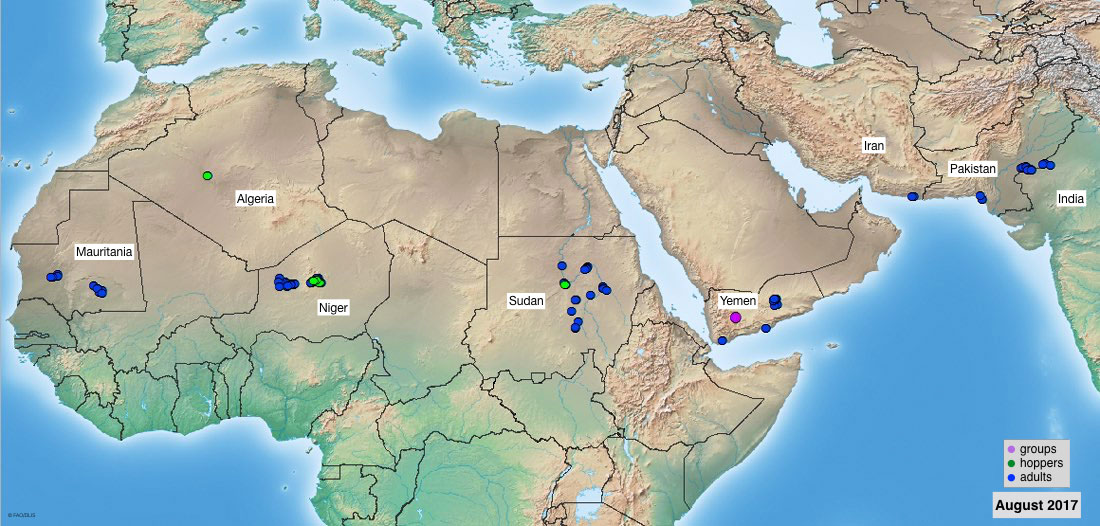
Current situation.
1 August. Good rains continue in summer breeding areas
The current Desert Locust situation remains calm.
Control operations were undertaken in Iran and, to a lesser extent, in Algeria where small-scale breeding had occurred in June and July. Low numbers of solitarious adults are present in the summer breeding areas of Mauritania, Sudan and along both sides of the Indo-Pakistan border.
Good rains have fallen in all summer breeding areas of the Sahel in West Africa and Sudan, in the interior of Yemen and along the Indo-Pakistan border. Consequently, small-scale breeding is expected to occur in all of these areas during August, causing locust numbers to increase slightly.
Regular surveys should be conducted in all areas wherever possible.
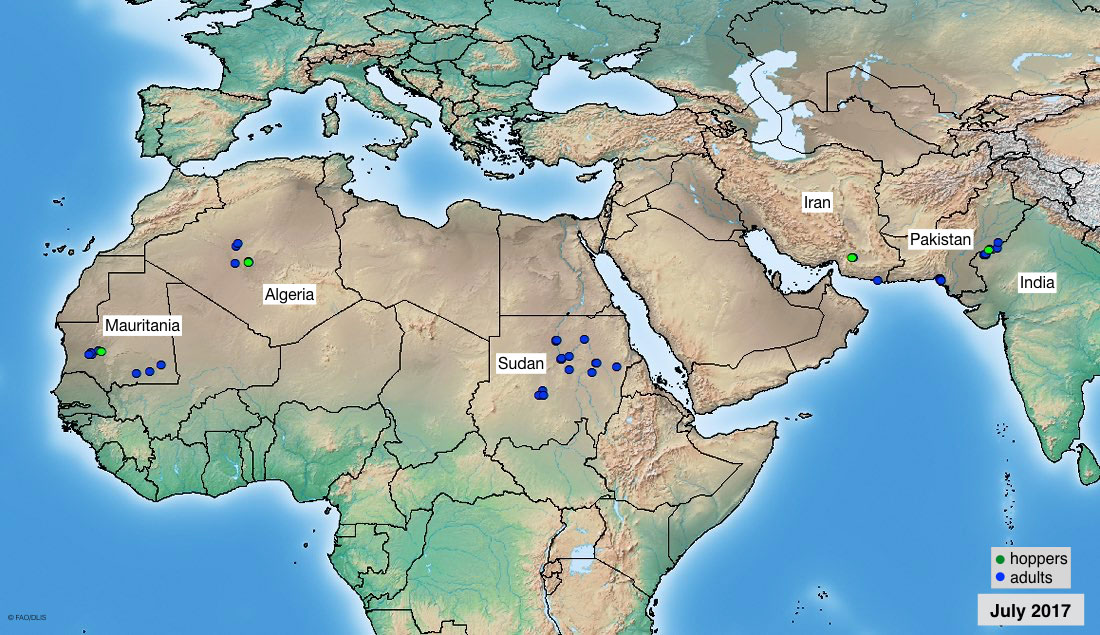
Current situation.
4 July. Good rains fall early in summer breeding areas
The Desert Locust situation continues to remain calm.
During June, preventive control operations were undertaken against localised infestations of hoppers and adults in Algeria and Iran. Elsewhere, only low numbers of solitarious adults are present in the northern and eastern interior of Sudan.
Unusually early and good rains fell during June throughout most of the summer breeding areas in the northern Sahel of West Africa and Sudan as well as along both sides of the Indo-Pakistan border. This will cause ecological conditions to become favourable for breeding earlier than normal and could allow for two generations of summer breeding this year, especially as the current seasonal forecasts are suggesting above-average rains from July to September in parts of the Sahel.
Consequently, locust numbers are expected to increase slightly in all summer breeding areas during July and August. Ground surveys should commence and continue on a regular basis throughout the summer as part of monitoring and early warning efforts.
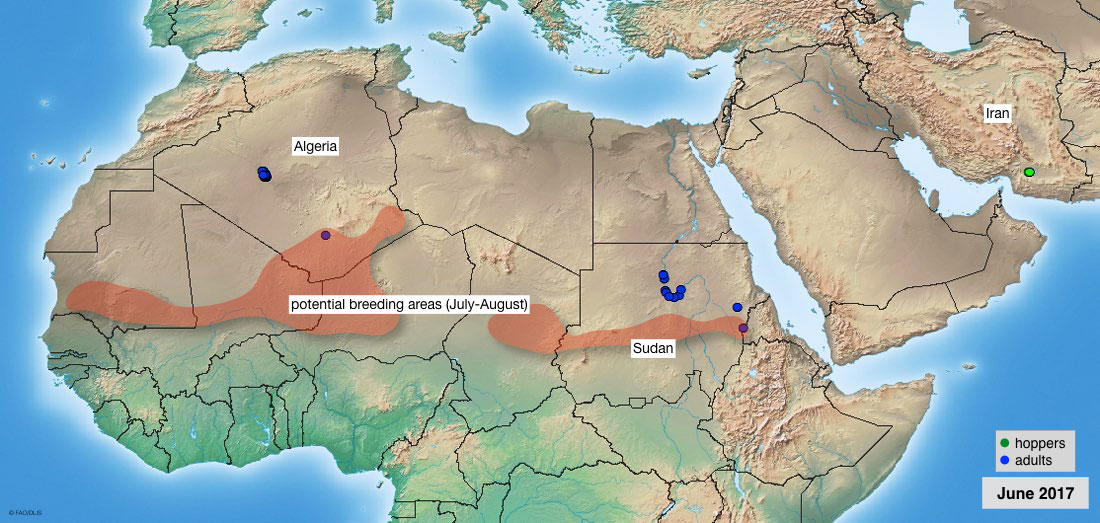
Current situation.
2 June. Preventive control in NW Africa and early rains fall in summer breeding areas
The Desert Locust situation continues to remain calm. Preventive control measures were undertaken recently against a few small hopper groups south of the Atlas Mountains in Morocco and Algeria. In Southwest Asia, low numbers of adults and local breeding were reported in southeast Iran.
During May, unusually heavy rains fell in some Red Sea coastal areas at a time when rain normally does not occur. The rains may be particularly important in Saudi Arabia (Qunfidah–Jizan), Yemen and Eritrea where follow up surveys should be conducted to monitor the situation. Good rains also fell in the interior of Yemen where small-scale breeding may occur during the summer, and on the Somali plateau in northern Somalia and eastern Ethiopia.
Early rains fell in parts of the summer breeding areas in Mali and Niger as well as along the Indo-Pakistan border. Small-scale breeding will cause locust numbers to increase slightly in the summer breeding areas of the northern Sahel between Mauritania and western Eritrea once the seasonal rains commence. A similar situation will occur along both sides of the Indo-Pakistan border where the monsoon is predicted to reach Rajasthan, India by the end of June and Cholistan, Pakistan by mid-July.
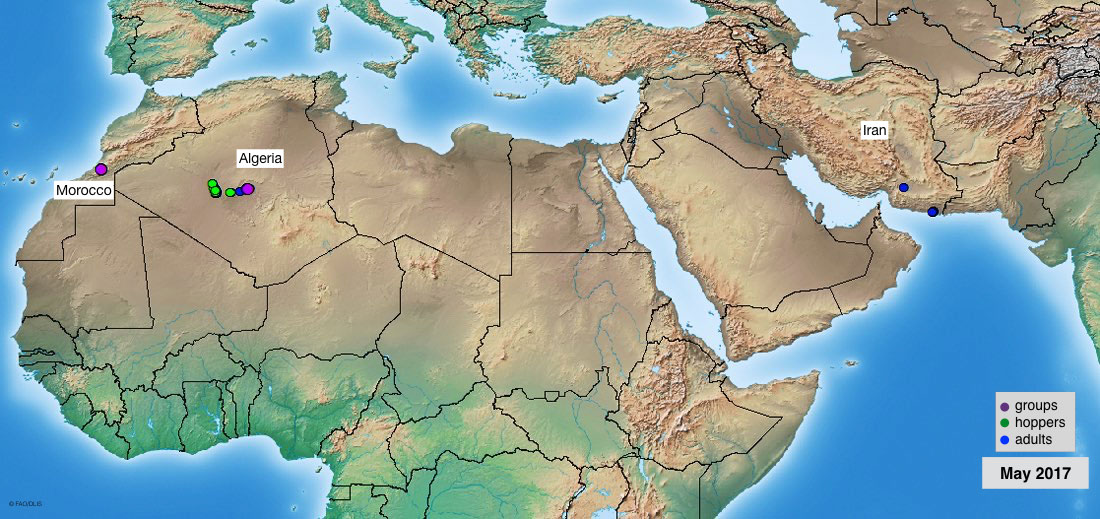
Current situation.
3 May. Desert Locust situation remains calm but limited spring breeding may still occur
The Desert Locust situation is currently calm. Low numbers of solitarious adults are present in Mauritania, Morocco, Algeria, Egypt and Iran. The situation continues to remain unclear in Yemen where surveys cannot be conducted.
During the forecast period, small-scale breeding could occur in parts of the interior in Saudi Arabia and Yemen, and in a few places in northeast Morocco, central Algeria and southeast Iran. Although this may cause locust numbers to increase slightly, they will remain below threatening levels and no significant developments are likely.
Regular surveys should be conducted throughout the spring to monitor the situation and prepare for the summer breeding period.

Current situation.
4 April. Desert Locust situation remains calm but limited spring breeding is expected
The Desert Locust situation improved during March and became calm in all countries. Low numbers of locusts are present in a few countries and limited ground control operations were carried out in Morocco. Small-scale breeding is expected to occur during the spring in the interior of Saudi Arabia, Yemen and southeast Iran where good rains fell in March. Although this will cause locust numbers to increase slightly, they should remain below threatening levels. Spring breeding will also occur in Northwest Africa if more rain falls along the southern side of the Atlas Mountains.
Regular surveys should be conducted throughout the spring to monitor the situation and prepare for the summer breeding period.
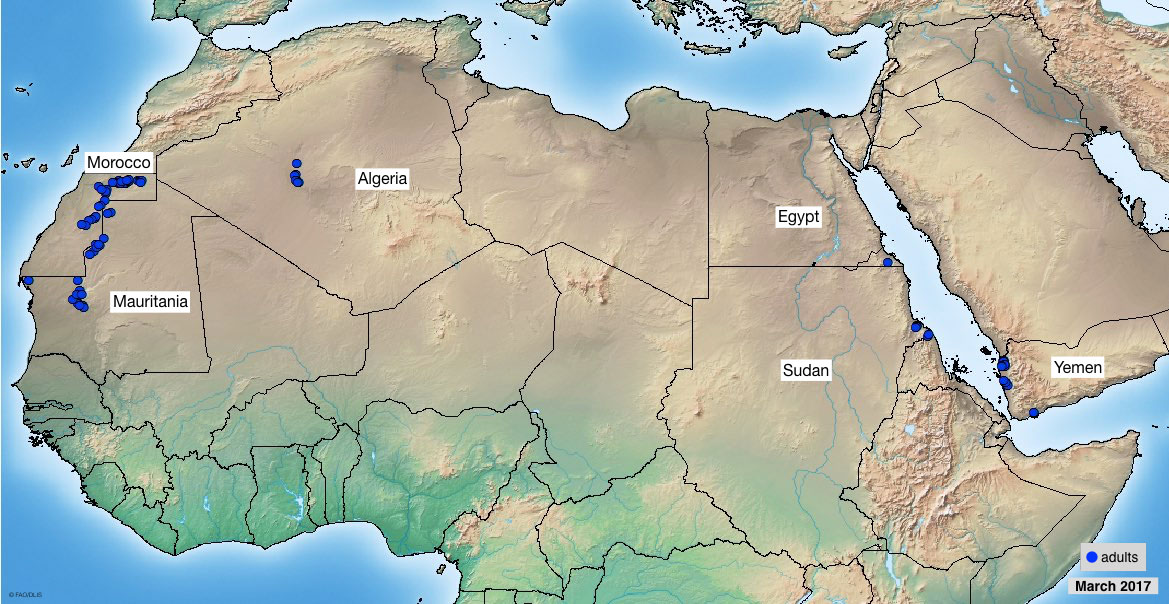
Current situation.
2 March. Desert Locust situation improves
The Desert Locust situation improved during February. Intensive control operations reduced infestations along the Red Sea coast in Saudi Arabia and locusts declined on the coast of Sudan as vegetation dried out. In Northwest Africa, limited control was undertaken against a few residual adult groups in northwest Mauritania.
During the forecast period, adults will shift from winter to spring breeding areas. This may be most noticeable in Saudi Arabia where adult groups and perhaps a few small swarms could form on the coast and move inland. Small-scale breeding is likely to occur in northern Mauritania, along the southern side of the Atlas Mountains in Morocco and Algeria, in the Nile Valley of northern Sudan and in southeast Iran but locust numbers are expected to remain below threatening levels in all areas.
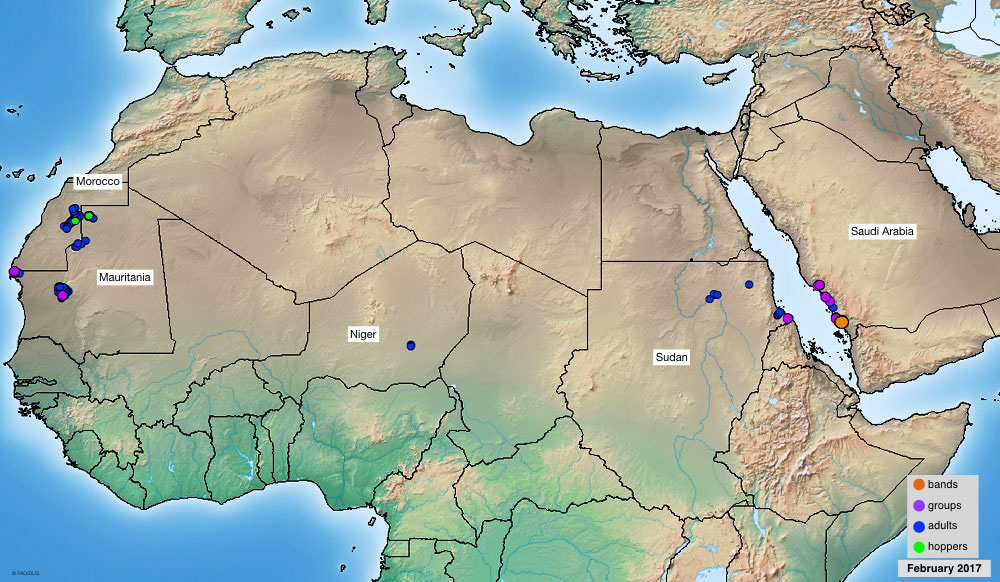
Current situation.
2 February. Control operations in progress in Saudi Arabia
Ground and aerial control operations are currently underway in Saudi Arabia where a Desert Locust outbreak developed last month on the Red Sea coast as a result of unusually good rains last summer. So far, two generations of breeding have occurred on the coastal plains south of Jeddah between Lith and Jizan, and late instar hopper groups and bands have formed. Groups of immature adults and perhaps a few small swarms are expected to form in the coming weeks. This is likely to be supplemented by third-generation hatching and band formation.
The situation is compounded by a lack of field operations in adjacent coastal areas of Yemen due to prevailing insecurity.
The infestations will remain confined to the Red Sea coast of Saudi Arabia as long as ecological conditions stay favourable, but there is also a risk that adult groups and small swarms, if they form, could move north along the coast as well as into the spring breeding areas of the interior as temperatures warm up.
All efforts should be undertaken to monitor the situation intensively by increasing survey teams and to conduct safe and effective control operations for preventing further breeding and migration to spring breeding areas.
Elsewhere, limited control operations were carried out recently against infestations along the Red Sea coastal plains on both sides of the Sudan-Eritrea border, in northwest Mauritania and southern Morocco.
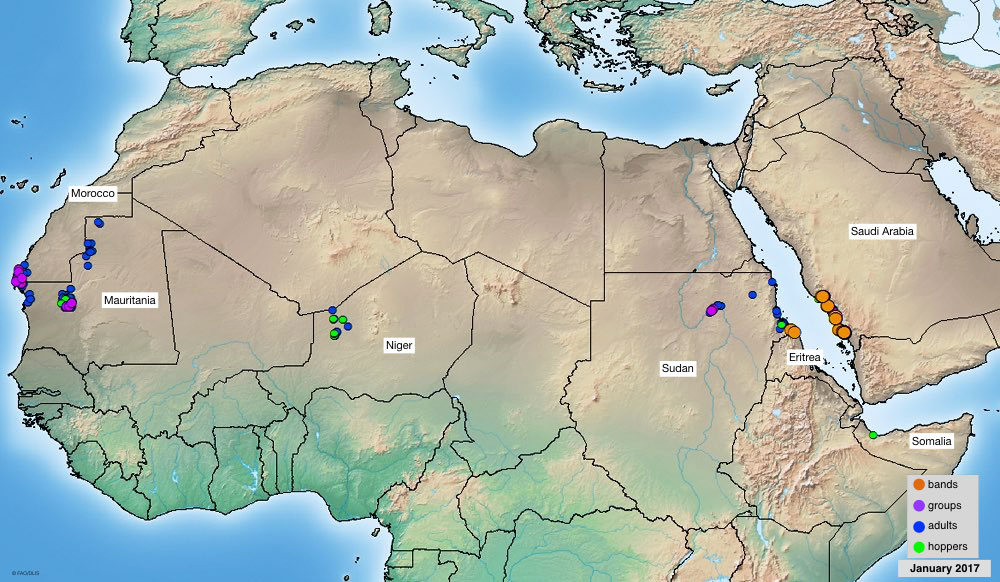
Current situation.
25 January. Desert Locust outbreak in Saudi Arabia
A Desert Locust outbreak has developed on the Red Sea coast of Saudi Arabia as a result of unusually good rains from July to mid-September 2016. So far, two generations of breeding have occurred on the coastal plains south of Jeddah between Lith and Jizan, and ground control operations are in progress.
The situation was exacerbated by irregular and incomplete surveys in the past few months as well as the likelihood that adult groups probably arrived from adjacent areas of Yemen.
Most of the current infestations consist of second-generation hoppers that have formed groups and small bands. However, a third generation of breeding is likely to already be in progress by some early second-generation adults that have matured and laid eggs, which are expected to hatch in the coming days.
In early February, immature adult groups and small swarms are likely to form from the current hopper band infestations. This will be supplemented by third-generation hatching in which hoppers will form groups and bands.
The infestations will remain confined to the Red Sea coast as long as ecological conditions stay favourable, but there is also a risk that infestations could expand to the plains north of Jeddah. Once vegetation dries out on the coast, adults will move into the spring breeding areas of the interior.
All efforts should be undertaken to monitor the situation intensively by increasing survey teams and to conduct safe and effective control operations for preventing further breeding and migration to spring breeding areas.
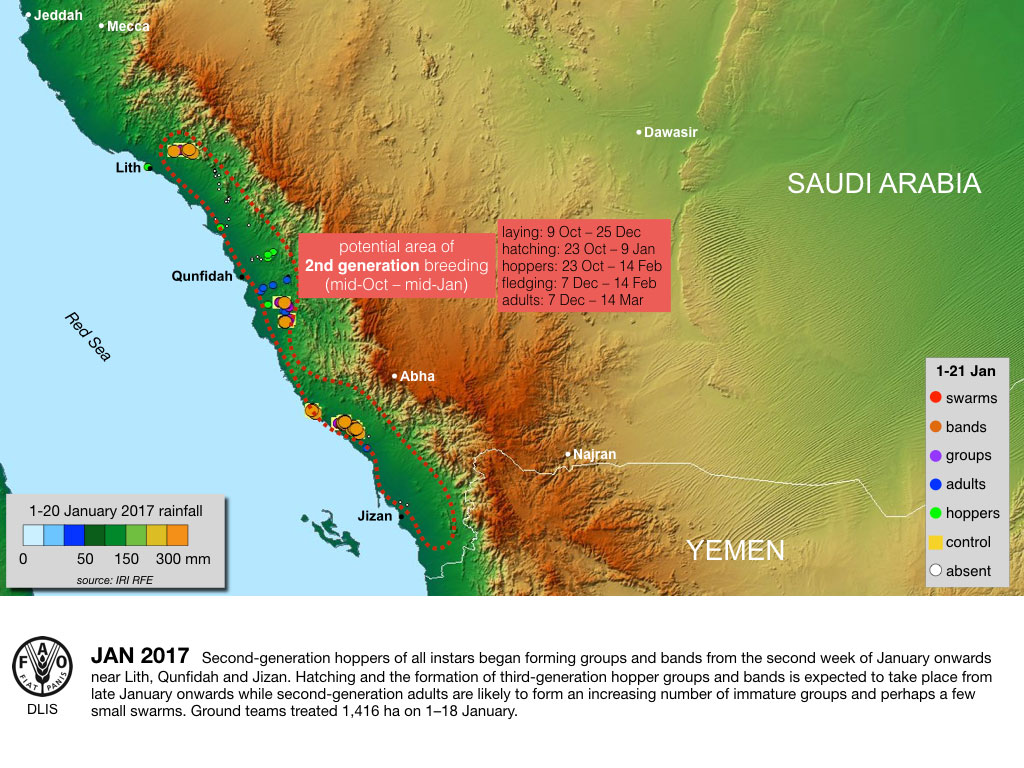
Current situation in Saudi Arabia.
3 January. Desert Locust infestations decline in Mauritania and Eritrea outbreaks
Desert Locust infestations declined during December in the areas affected by the recent outbreaks in Mauritania, which extended to southern Morocco, and in Eritrea due to ongoing control operations. Nevertheless, strict vigilance should be maintained as ecological conditions continue to remain favourable and another generation of breeding is likely to take place during January and February.
As temperatures increase in the coming months, hatching with the possibility of small hopper groups forming is likely in parts of northwest and northern Mauritania and adjacent areas of southern Morocco. Adult groups that are currently present will probably move back and forth between both countries.
In Eritrea, ground control operations have reduced locust infestations on the central coast and avoided crop damage. However, several adult groups moved to the northern coast and laid eggs that hatched and small hopper bands are forming. A few adult groups reached adjacent areas on the coast of Sudan where small-scale breeding is in progress and control was undertaken. Breeding is also underway in a few areas along the Red Sea coast of Saudi Arabia and Yemen. Limited control operations were carried out recently in both countries.
Elsewhere, low numbers of adults are present in Algeria, northern Niger and northwest Somalia.
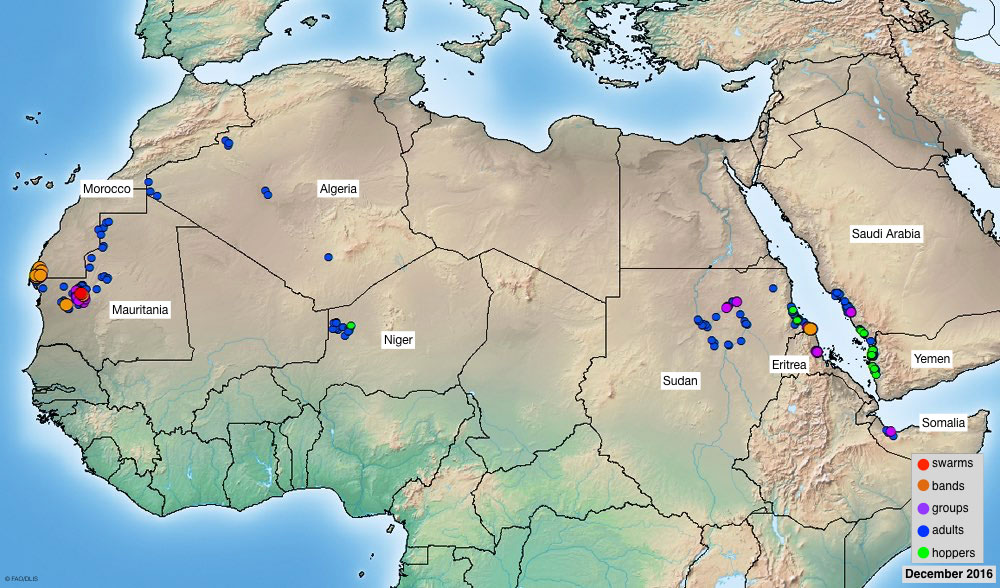
Current situation.




